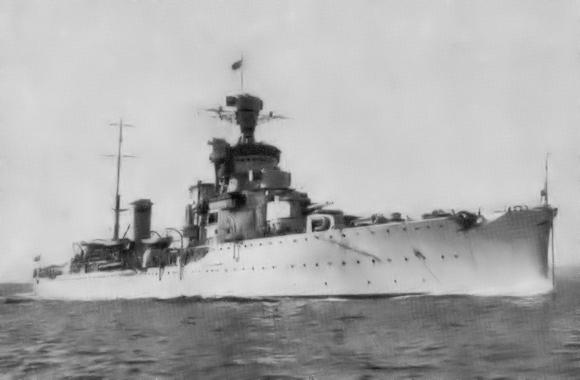At the end of the 1941, the situation in North Africa was disastrous and the British forces were advancing under the impetus of the operation "Cruisader" (Crusader). The fuel was almost over; the Axis vehicles could not operate, the planes assigned to the Tripoli defense could not fly and the defeat seemed inevitable. Once again, the Royal Navy was called to deliver supplies to the besieged colony. With the arrival of force B in Malta the November 29 in command of Admiral Rawling and strong cruisers Ajax e Neptune and of the destroyers Kimberly e Kingstone, the British took control over the central Mediterranean. At that time, numerous national merchant shipping was lost on the routes to Africa, including: M / n Veniero and the ships: Cape Faro, Adriatic e Mantovani; therefore Supermarina decided the December 4, to use military ships to transport the provisions for Libya. Light cruisers were chosen Alberto di Giussano (photo opening) e Alberico from Barbiano, constituting the IVth Division, under the command of the division Admiral Antonino Toscano, who first raised his banner onAlberto di Giussano, moving it later onAlberico from Barbiano, a ship that he had previously commanded as a boat captain.
The general staff of the two cruisers had the news, while they were moored at the naval base of the Mar Piccolo in Taranto, where the two ships were from the month of August. According to the mission, a third cruiser, the Giovanni dalle Bande Nere, started from the base of La Spezia had to join the from Barbiano and from Giussano in the port of Palermo, to take its load and continue with them towards Tripoli. Meanwhile the cruiser Cadorna, he managed to deliver fuel and personnel to Benghazi.
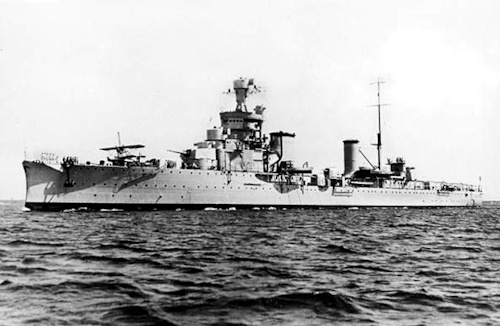 L'Alberto di Giussano under the command of vessel captain Giovanni Marabotto andAlberico from Barbiano (photo) under the command of the captain of the vessel Giorgio Rodocanacchi, with the Tuscan admiral on board, on the morning of 5 December they left their moorings from Taranto, towards Brindisi where they arrived at the commercial quay, at about 17:00 the same day, to embark the material to be sent to Tripoli. The two units moved to Palermo as soon as the loading operations were completed and moored on the morning of 7 December, at the Piave pier. In that port there was also the Bande Nere, arrived from Spezia a few days before, ready to take his load. But this cruiser, due to problems with his engine, had to give up the supply mission, and was replaced by the torpedo boat Swan.
L'Alberto di Giussano under the command of vessel captain Giovanni Marabotto andAlberico from Barbiano (photo) under the command of the captain of the vessel Giorgio Rodocanacchi, with the Tuscan admiral on board, on the morning of 5 December they left their moorings from Taranto, towards Brindisi where they arrived at the commercial quay, at about 17:00 the same day, to embark the material to be sent to Tripoli. The two units moved to Palermo as soon as the loading operations were completed and moored on the morning of 7 December, at the Piave pier. In that port there was also the Bande Nere, arrived from Spezia a few days before, ready to take his load. But this cruiser, due to problems with his engine, had to give up the supply mission, and was replaced by the torpedo boat Swan.
The danger of the company was immediately clear when they arrived on board the from Barbiano, number of non-watertight stems, containing aviation fuel to be used by the aircraft of the axis. The 11 December the from Barbiano e of Giussano they left Palermo bound for Tripoli, but they were spotted by British planes, so Admiral Toscano decided to return to port. The English, thanks to the interceptions ofIncredibly , they learned of Italian plans, and alerted the 4th Destroyer flotilla, composed of four destroyers: HMS Sikh (next picture), HMS maori, HMS Legion and the Dutch destroyer Isaac Sweers.
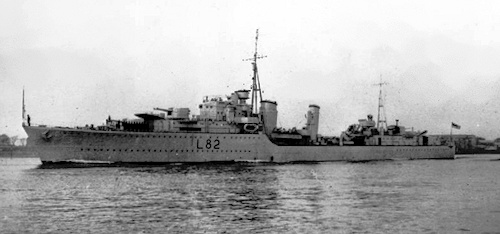 So it was that the two cruisers, loads of fuel mostly placed in bins on deck: 100 t. of petrol, 250 t. of diesel, 600 t. of naphtha, 900 t. of supplies and 135 military. Plus many other drums, which cluttered, along with sacks of flour, pulses, cannon shells and every kind of supply, even coming to be crammed on the deck, making it impossible to tilt the towers of the main pieces from 152, thus precluding any possibility of defense. The ships were also noticeably burdened by the unusual load, and it was difficult even for the staff to pass from one place to another. Additional firefighting teams equipped with asbestos suits were boarded for the occasion.
So it was that the two cruisers, loads of fuel mostly placed in bins on deck: 100 t. of petrol, 250 t. of diesel, 600 t. of naphtha, 900 t. of supplies and 135 military. Plus many other drums, which cluttered, along with sacks of flour, pulses, cannon shells and every kind of supply, even coming to be crammed on the deck, making it impossible to tilt the towers of the main pieces from 152, thus precluding any possibility of defense. The ships were also noticeably burdened by the unusual load, and it was difficult even for the staff to pass from one place to another. Additional firefighting teams equipped with asbestos suits were boarded for the occasion.
At the 17: 24 of the 12 December 1941, the two ships, let go the moorings. The anchor of the from Giussano, as a fatal sign, did not want to come up, and to save time, the commander Marabotto, decided to make it disconnected from the chain leaving us a buoy, sure to recover it at the end of the mission. The anchor was then recovered and placed in Piazza Quattro Canti, in front of the UNUCI office in Palermo.
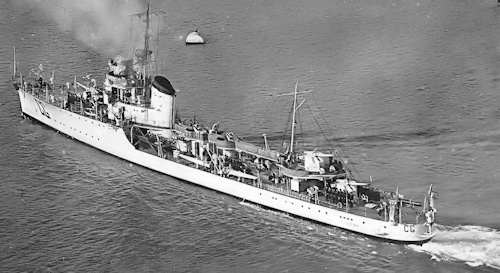 The two ships overcame the obstructions of the port, took off and disappeared at the sight of the last shores of the Italian coast, which they would never see again. The torpedo boat Swan (photo), under the command of Corvette captain Riccardi, who left Trapani shortly thereafter, met the two cruisers off Marettimo and headed the formation, thus constituting the miserable and symbolic escort of these two warships transformed into cisterns .
The two ships overcame the obstructions of the port, took off and disappeared at the sight of the last shores of the Italian coast, which they would never see again. The torpedo boat Swan (photo), under the command of Corvette captain Riccardi, who left Trapani shortly thereafter, met the two cruisers off Marettimo and headed the formation, thus constituting the miserable and symbolic escort of these two warships transformed into cisterns .
At 02: 45 an English scout flew the formation undisturbed, communicating course and speed of the Italian convoy to the 4 English units, which were between Zembra and Zembretta. Admiral Toscano sensing what was happening, but considering it now impossible to reverse the route again, gave the order to increase the speed of 30 nodes thus reaching the 03: 00 13 December in view of the lighthouse of the black and white promontory of Capo Bon, the training had just doubled the promontory with the avant-garde of the torpedo boat Swan, from Barbiano and from Giussano behind, all in line in a row. When, about a couple of miles from the coast, we noticed the black and thin shapes of the enemy ships, which sailed below the coast in order to merge with the heights of the Tunisian promontory and be able to conduct the attack by surprise.
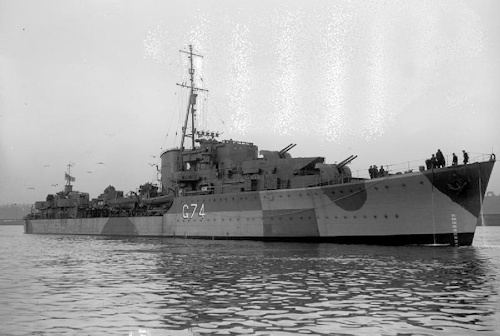 At 03: 15, with the help of the Radar and completely in secret, the British maneuvered in launch position and launched ten torpedoes, and starting with the cannons on board, a targeted shot towards the Italian units. At 03: 20 the from Barbiano he was hit by several cannon shots on deck and on the bridge, immediately taking fire and practically jumping in the air, after a few minutes. Centered also by a torpedo, it turned upside down and at 03: 35 sank, leaving on the point an authentic sea of flames. The admiral and the staff of the unit disappeared into the sea and like them, almost all the personnel boarded. The from Giussano, was hit at 03: 24, by two torpedoes launched by him Legion (photo), which burst to the left, near the engine room in the bow. Trimming with the blast, the large steam pipes, scalding most of the machine personnel and stopping the engine, which moved the propeller of the left axle. Other shots fell very close to the ammunition depots of the cannons from 100 / 47, so, to prevent the explosion, the surrounding areas were ordered to be flooded immediately. In this way the ship, due to the large amount of water on board, slowed down further until it finally stopped. Now also the from Giussano, in the prey of the flames it was hopelessly lost. The commander Marabotto assessed the desperate conditions, ordered ship abandonment and a large part of the personnel, dived into the sea from the stern and took his place in the life rafts crammed on board. Escaped from death on board, the situation of the shipwrecked ones in the water was aggravated, because of the numerous fires that blazed on the surface of the sea, full of naphtha and the presence of many sharks in the area.
At 03: 15, with the help of the Radar and completely in secret, the British maneuvered in launch position and launched ten torpedoes, and starting with the cannons on board, a targeted shot towards the Italian units. At 03: 20 the from Barbiano he was hit by several cannon shots on deck and on the bridge, immediately taking fire and practically jumping in the air, after a few minutes. Centered also by a torpedo, it turned upside down and at 03: 35 sank, leaving on the point an authentic sea of flames. The admiral and the staff of the unit disappeared into the sea and like them, almost all the personnel boarded. The from Giussano, was hit at 03: 24, by two torpedoes launched by him Legion (photo), which burst to the left, near the engine room in the bow. Trimming with the blast, the large steam pipes, scalding most of the machine personnel and stopping the engine, which moved the propeller of the left axle. Other shots fell very close to the ammunition depots of the cannons from 100 / 47, so, to prevent the explosion, the surrounding areas were ordered to be flooded immediately. In this way the ship, due to the large amount of water on board, slowed down further until it finally stopped. Now also the from Giussano, in the prey of the flames it was hopelessly lost. The commander Marabotto assessed the desperate conditions, ordered ship abandonment and a large part of the personnel, dived into the sea from the stern and took his place in the life rafts crammed on board. Escaped from death on board, the situation of the shipwrecked ones in the water was aggravated, because of the numerous fires that blazed on the surface of the sea, full of naphtha and the presence of many sharks in the area.
At 04: 30 approximately, after just one hour from the first stroke on board, theAlberto di Giussano, first unit of the homonymous class Condottieri it broke into two sections and sank to 2,5 miles east-south-east of Cape Bon, about a thousand meters fromAlberico from Barbiano, sunk almost immediately, after being hit. Many castaways were collected by the torpedo boat SwanAlmost all of them were slippery when touched, because they were full of heavy naphtha and had come out of the deposits of the two cruisers sunk and had thickened on the surface of the sea. The most critical ones were immediately sent to the on board showers to remove the annoying oil from the body, which blinded and scraped the open wounds together with the salt, and the most colds were taken to the boiler room. The Swan at dawn, he headed north and unloaded to Trapani, in the early afternoon of December 13, his painful load, about 500 survivors. Other shipwrecks were picked up by Tunisian locals, others by an Italian seaplane ditched in the area, while the rest was recovered by Italian MAS. The missing at sea amounted to more than 900 people, including the Admiral Toscano. In all, the survivors were about 645.
The only English error was in believing that the Bande Nere was present at the clash, but this was probably caused by the fact that the order for the replacement of the stock at Swan it was not transmitted by radio and therefore was not intercepted.
Class "Military leaders" built on the design of General Vian. They constituted a class, of 4 units: Tree by Giussano, Alberico da Barbiano, Bartolomeo Colleoni e Giovanni delle Bande Nere.
Alberto di Giussano
Light cruiser, of the Regia Marina, first in the class Condottieri, baptized in honor of Alberto di Giussano, the knight who according to legend led the defense of the carroccio to the Battle of Legnano
In the thirty he participated in the normal activities of the fleet, as a unit of the 2 ° Squadron. The 10 Jun 1940 together with the 1 ° Squadron was part of the 4a Cruiser Division and participated in the Battle of Punta Stilo in July, and for the rest of the year acted as remote coverage for convoy troops and supplies to North Africa.
General description
Ansaldo Shipyard Builders of Genoa: set in 1928 - launched in 1930 - entered into service in 1931
Displacement: 6.570 t (standar): 6.954 t (full load
Length: 169,3 m - width 15,5 m
Propulsion: 6 boilers, 2 turbines, 2 propellers - Power: 95.000 HP
Crew: 507 men, including official 19
Speed: 37 nodes
Armament:
8 pieces from 152 / 53 mm model Ansaldo 1926 (4 coupled installations)
6 pieces from 100 / 47 mm model OTO 1926 (3 coupled installations)
8 machine guns from 37 / 54 mm (4 coupled installations)
8 machine gun from 13,2 / 75,7 MG model 1931 (4 coupled installations)
Torpedoes: 4 torpedo tubes from 533 mm
Board two planes Imam Ro 43
In the 1938 / 39 the pieces from 37 / 54 were replaced with pieces from 20 / 65 and two antisubmarine spearheads were loaded
Alberico from Barbiano
Light cruiser, of the Royal Navy, baptized in honor of the fifteenth century captain of fortune Alberico da Barbiano.
He entered the service in the early 1930s and carried out missions in the western Mediterranean during the Spanish Civil War. The 10 Jun 1940 together with the 1 ° Squadron was part of the 4a Cruiser Division and participated in the battle of Punta Stilo in July. He acted as remote coverage for convoy troops and supplies to North Africa. He performed 7 war missions along 13.241 miles.
General description
Like the twin from Giussano
(photo: web)

